Long White Gypsy uses affiliate links and is a member of the Amazon Services LLC Associates Program. If you make a purchase using one of these links, I may receive a small commission at no extra cost to you. See my Privacy Policy for more information.
You might think that being out in the middle of nowhere, seeking solitude in the vast expanses of open air and towering peaks of the mountains, means that you don’t have to worry much about other people and your interactions with them. But nothing could be far from the truth.
When I first started properly hiking over 5 years ago, I noticed there was an unspoken code that hikers operated by. Some of it was common sense, but some of it was completely new to me (like how to leave a hut when you’re finished with it, or what the proper side of the trail to hike & pass on is).
Just as the Leave No Trace principles exist to protect the natural and physical environment from overuse and human impact, I learned that there are also certain principles of hiking etiquette to be aware of when using the trails and their facilities.
To stop you from suffering the same fate, I want to make sure you’re aware of them now, so you can avoid being a total d*ck on the trails!
So here are 11 simple hiking etiquette rules to avoid being a nuisance to fellow hikers when exploring the NZ tracks and trails.
1 — Give Way to Other Trail Users.
The first of these unwritten rules of trail etiquette is to give way to other track users regardless of whether you’re a tramper, biker or bringing your furry friend along.
General Give Way Rules
The first general rule of trail etiquette passing is to hike on the left and pass on the right.
If you’re on a narrow track and another tramper is approaching step aside (to the left side of the track) and allow them to pass. If you’re a slower tramper, give way to faster walkers by stepping out of the way as soon as there’s a safe place to do so.
If you’re hiking in a group, make sure you and your fellow hikers walk in single file and step aside for any approaching hikers.
Hiking Etiquette Right of Way
The second general rule of hiking etiquette passing is that downhill hikers yield to hikers going uphill.
We call this the hiking right of way.
If walking on an uphill section of track, then the hiking going downhill should give way to any uphill hikers. Again, downhill hikers should find a safe place to step off the track and allow the uphill hikers to pass (although often the person going uphill will welcome the break and reverse this scenario).
2 — Multi Use Trail Etiquette.
Many of New Zealand’s most popular trails are now ‘shared use’ between trampers and mountain bikers or other users.
So the next of these rules of hiking trail etiquette is to be considerate of other users on shared use tracks.
This includes:
- Making sure to keep unnecessary noise to a minimum (so no blasting your fav music out loud!);
- Being aware of your surroundings at all times (so no wearing both headphones when listening to music!);
- Trying to be compassionate and helpful to fellow hikers.
The trails can be an unnerving place, especially for newbies, so this isn’t the place to be overly critical or outright rude/aggressive.
Trail Etiquette Mountain Biking
Here are some general rules for hiking etiquette on mountain biking trails for hikers:
- Keep your eyes and ears open, and be alert at all times (no listening to music through headphones);
- Be ready to get out of the way quickly (unfortunately some bikers aren’t as courteous as others);
- Stick to the left at all times;
- Be ready to stop at any time to let a bike pass.
And now for some general trail rules for mountain bikers on shared use trails:
- Always give way to hikers and trampers;
- This includes going slowly on downhill or twisty sections of track where you can’t see very far ahead;
- Slow down and be prepared to encounter hikers at any time.
- Sound your bell when approaching hikers and trampers, but don’t alarm walkers who may not hear you until the last moment. Gently approach at a slow pace whilst calling out to them.
There are of course situations which fall outside of this and require a bit of common sense.
For example if you come across a mountain biker trying to lug their bike up/down a narrow/hilly section, it’s a nice courtesy to step out of the way and allow them to pass before you continue on.
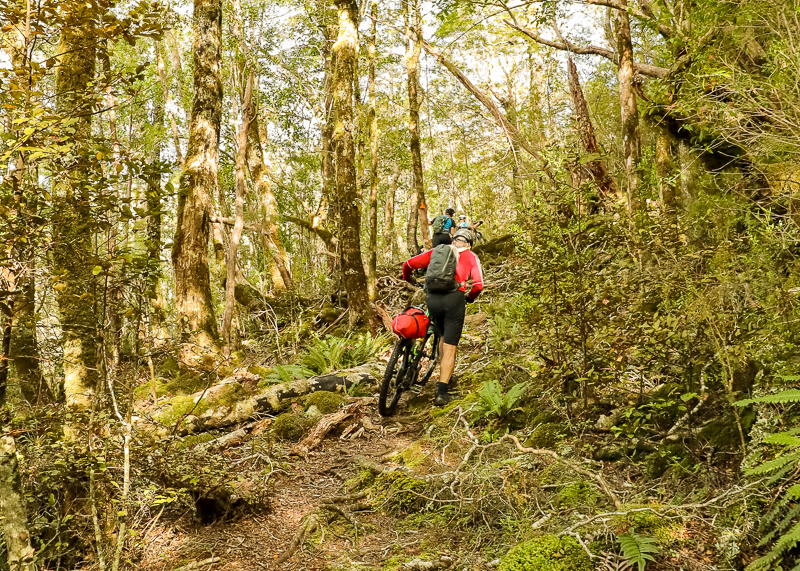
Trail Etiquette Dogs
If you’re going hiking with your dog, it’s good practice to follow these hiking rules for trail etiquette with your four legged friend:
- Step aside and allow fellow hikers to pass when safe to do so.
- If you’re faster, call out to your fellow hiker ahead and let them know you have a dog. Give them time to step aside before passing them with plenty of room.
- Be aware that not all people are dog people. Practice good trail etiquette by keeping your dog on a short leash around fellow hikers, and allowing them to get a little way ahead before continuing.

We’ll talk more about how to be a responsible dog owner on the trails a bit further on.
Trail Etiquette Horses & Other Animals
You might encounter horses on some trails. The general hiking rules when passing horses and their riders is for the hiker to pass the horse on the downhill side of the trail. This is because horses tend to run uphill if they get spooked.
Regardless, if you encounter another trail user with an animal, it’s good practice to use your common sense and have a quick conversation about how best to approach the situation so that everyone is comfortable.
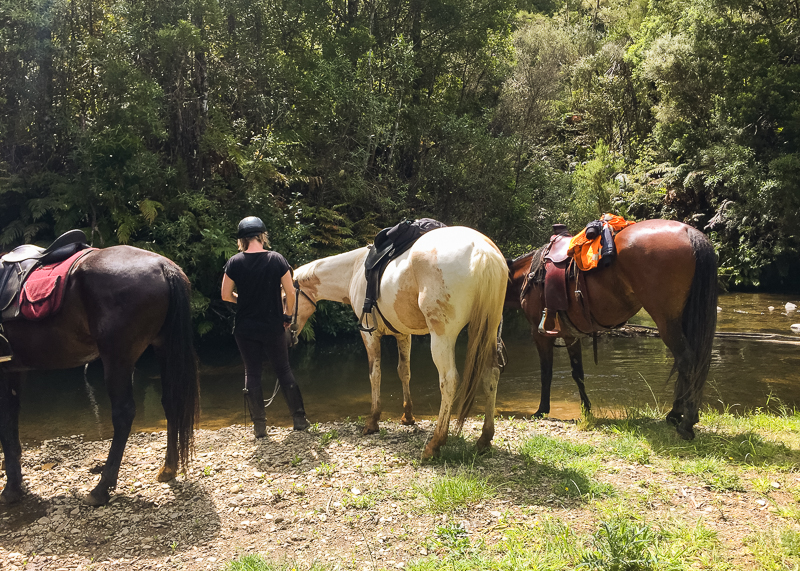
Quad Bikes, ATVs or Trail Bikes
Sometimes you might find yourself on a trail which is also used by quad or trail bikes.
These vehicles are usually loud enough that you should have plenty of warning, but they may take up the entire width of the track.
If you hear a quad or trail bike, make sure you have as much clear trail as possible to give the driver time to see you when they appear. Try not to stop on a corner unless you can get well off the trail.
If the trail isn’t wide enough for you both to pass, decide whether it’s possible to walk back or forward a little way to a safe passing spot, or if there’s another way for you to get around.
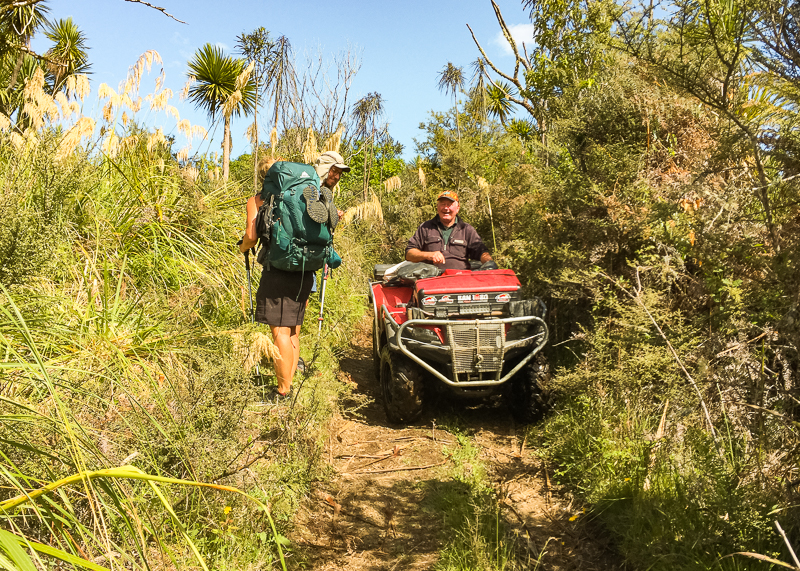
3 — Swap Info With Other Users.
Another one of the rules of hiking etiquette is to stop and have a chat with fellow hikers and trail users if you pass them on the trail. We call this the hiker grapevine and it’s a great way to find out information about what’s to come.
It also gives you an opportunity to ask if there are any obstacles or hazards up ahead that you need to be aware of (e.g. fallen trees or swollen rivers).
In return, you might also be able to provide useful information to your fellow hikers about the condition of the track you’ve just walked as well.
4 — Pack it in, Pack it out.
One of the non-negotiable rules for hiking is to follow leave no trace principles. Make sure you take only photos and leave only footprints.
If you create any rubbish whilst you’re out on the trail, secure it in a sealed bag or zip it away in a pocket and carry it out with you. This includes tissues and even toilet paper if you’re not in an area where it’s likely to biodegrade (i.e. above the bushline).
Don’t try to cheat by throwing your rubbish into fireplaces at huts or into toilets. Some rubbish releases harmful chemicals into the air if burned, and anything but human waste and toilet paper can cause blockages when a backcountry toilet is emptied.
Score extra points by picking up any other rubbish you come across which might have been dropped by fellow hikers (accidents happen, but some people are also serial litterers).
5 — Poo in a Loo.
And while we’re on that topic, try to always use the toilets on trails rather than going in the bush.
I get it. Sometimes emergencies happen and the urge can strike you unawares. That’s fine, it happens to the best of us. Make sure you’re prepared by carrying a proper toilet kit with you at all times.
But for all the other times, know that most tracks in NZ (especially the popular ones) have plenty of toilets for you to use along the way. So use them, and try to avoid toileting in the bush.

⚠️ IMPORTANT NOTE
If you’re heading to NZ from overseas you should know that the locals don’t take kindly to relieving yourself anywhere other than in a toilet. An increasing number of visitors in past years have failed to respect this rule, spoiling our most pristine natural environments. Respect the locals and the environment by always using a toilet or following Leave No Trace principles.
If the urge strikes unawares, please follow the Leave No Trace toileting rules:
- Find a spot at least 50 m / 1 yd from the track and any water sources.
- Choose a spot where your waste will decompose quickly (i.e. ground which is full of rich organic matter (such as forests).
- Dig a hole at least 15 cm / 6 in deep and do your business in it.
- Use a leaf or a few squares of toilet paper to clean up, and discard those in the hole.
- Fill the hole back in and cover it over with some leaves or sticks.
If you’re in an area where your waste won’t decompose properly underground (i.e. in an alpine environment or above the bushline) carry a poo pot with you or bring your own from home.
6 — Stick to the Marked Tracks.
Frequent usage of popular tramping tracks can cause sections of track to get very boggy and muddy with deep (sometimes knee-high) sucking mud.
This becomes worse as each successive group of walkers tries to avoid the mud by going around, rather than through it. The wider the mud becomes, the more of our forests are eroded away or turned into impassable bogs.
Although it can be frustrating, it’s far better for the environment for trampers to pick their way through the mud rather than skirting around it.
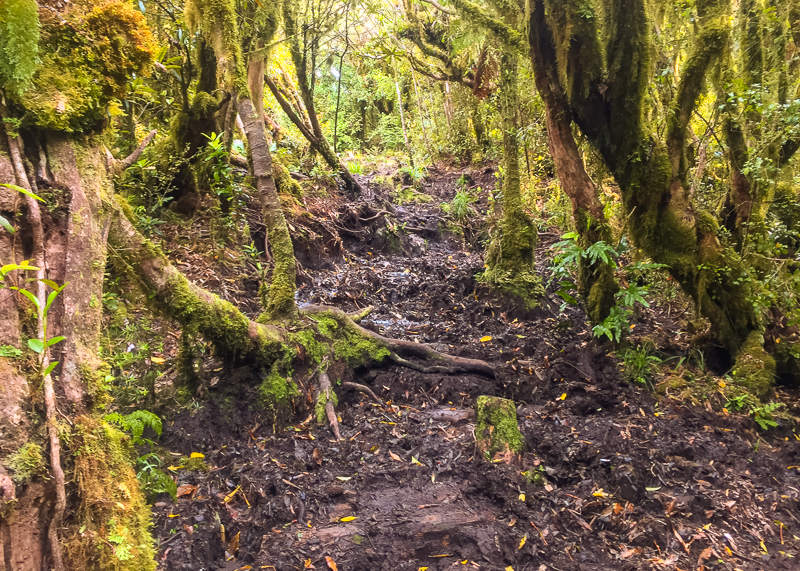
7 — No Cairns or Trail Souvenirs.
Another way to minimise your effect on the environment is to avoid the temptation to take souvenirs from the trails or build your own cairns or landmarks. In short – leave trails as you find them.
Here are some examples to illustrate the point:
Volcanic Rock Souvenirs
The Tongariro Alpine Crossing sees over 100,000 hikers every year. Imagine what would happen if every walker took one of the volcanic rocks home with them as a souvenir.
It wouldn’t be long before the trail looked very different, and there could be huge consequences for natural erosion patterns and the environment.
Creating or Adding to Cairns
In other countries, it’s common for cairns to be built or added to by hikers who wish to commemorate reaching a summit or completing a trail.
But in New Zealand (and in some other countries) cairns are used as trail markers. They often mark routes across dangerous alpine passes or ridges, or denote a place where the track takes a turn.
Creating a cairn where there shouldn’t be one might cause a tramper to veer off track without realising, and may result in injury or death.
8 — Keep Dogs Under Control (& bag their poop).
If you’re hiking with your furry friend, always do your research first and check that dogs are allowed on the trail you’re planning to hike.
We have strict rules in NZ about hiking with dogs to protect native birds (especially kiwi) many of which are ground-dwelling or lay their nests on the ground.
But that’s not the only reason. Sometimes dog restrictions are for their own good, for example if poison or bait drops have recently been conducted for pest control in the area.
Bringing Dogs on a Department of Conservation Track
If you’re planning to hike a Department of Conservation trail, the website page for the track will tell you whether you can bring your dog (and under what conditions).
As a general rule, dogs aren’t allowed in any New Zealand National Parks. That’s a real bummer for most of us dog owners, but them’s the brakes.
Apart from that, dogs are usually permitted in various Forest Parks (many of which double as popular hunting locations), but not always and in some places your dog might need special training or a permit before you can take them with you.
Find out more about bird aversion training for dogs here.
Bringing Dogs on Private Hiking Tracks
Not all hiking trails in NZ are managed by the Department of Conservation. Some are private tracks and trails over or through private land (or land managed by a trust etc.).
If you’re planning to hike on a private track, there won’t be as much information online about whether dogs are permitted. But you might be able to ask on an online forum (such as the Tramping in NZ facebook page).
Otherwise the rules about dogs will usually be signposted at the trailhead.
Be a responsible dog owner
Being a responsible dog owned in NZ means following the rules, and always keeping your dog under control.
In general, your dog should be on a leash (to protect other hikers and native wildlife) unless otherwise specified on the track website or trailhead signage.
Always pick up after your dog. Dog poop contains bacteria and pathogens which can be very harmful to the natural environment if allowed to decompose. Take baggies with you and carry out Fido’s poop just as you would other rubbish.
9 — Leave Gates as You Find Them.
Wherever you’re tramping in New Zealand, if you find yourself passing through a gate of any kind make sure to leave it as you find it.
If it’s open, leave it open. If it’s shut, close it behind the last member of your group.
Many tracks and trails in NZ go through working farms. Gates might be left shut to keep stock in (or out), or left open because stock is being moved (or will be moved in the near future).
To minimise any inconvenience to the farm owner or the potential loss of stock, always leave gates as you find them.
10 — Don’t Get Too Close to the Wildlife.
If you’re passing through a farm, don’t get too close to the stock or cattle (unless you absolutely can’t avoid them). Cows and sheep startle easily if surprised. Keep your distance from them and give them plenty of room to move.
Never come between a mother and her baby. And never block an animal’s exit route.
Whereas sheep will usually scatter as soon as they hear or see you coming, cows have a very narrow range of vision and can’t see anything which is approaching them from behind. Make a little bit of noise (but not too much) to let them know you’re there, and proceed cautiously.
And the same goes if you encounter any other kind of wildlife while out on the trails. Whether it’s birds, possums, rodents or larger animals such as wild pigs and deer, keep your distance and don’t feed the animals.
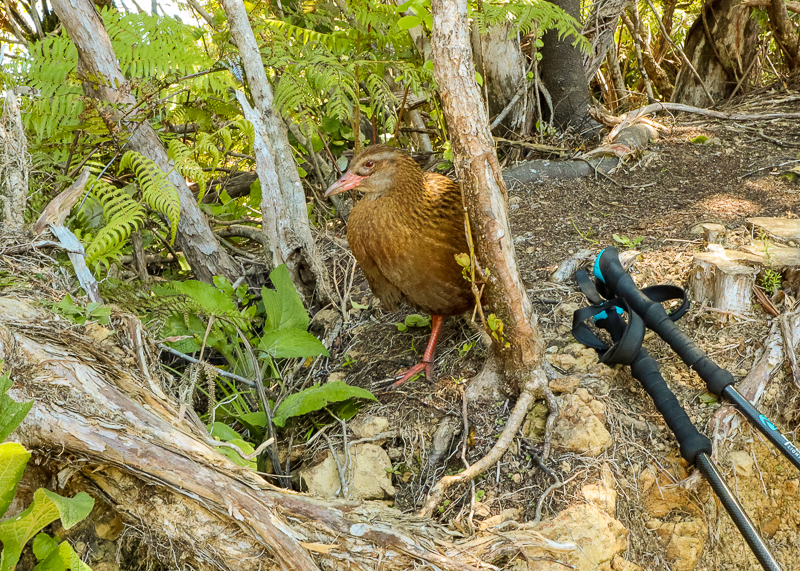
11 — Be Considerate of Others.
Our final (and most important) rule of hiking etiquette is to be kind and considerate around and towards all trail users, whether human or animal.
The wilderness is there for everyone to enjoy, and a little bit of courtesy goes a long way.
Here are some ways you can be considerate when you’re out on the trails:
- If you see something which is broken or needs attention, report it to the local Department of Conservation office when you get home.
- If you come across a tramper or trail user in need of help, do what you can to assist and check they’re ok.
- Be kind to those you encounter along the way.
- Keep noise and disturbance to a minimum. Avoid blasting personal music out loud even if there’s no-one around (headphones are preferred, but make sure to keep one ear free to stay aware of your surroundings).
- If you’re in a scenic spot, don’t monopolise the best viewpoint for taking photos if there are others waiting. Give them a chance to get the same photo as you.
A note on drone use in NZ
NZ has very strict drone rules (as is becoming the norm worldwide).
You can’t fly a drone on a private trail or over private land without the permission of the landowner.
You also can’t fly a drone over public conservation land (i.e. on any DOC trail) without a permit from DOC. Drones are completely prohibited in all but four of NZ’s 13 National Parks. A drone permit costs $65 plus GST per application, takes a minimum of 10 working days to process and may still be denied.
If you’re really desperate to fly your drone over conservation land, DOC has a list of South Island locations where a drone permit is more likely to be granted. DOC doesn’t recommend you apply to fly a drone in any North Island location.
Use these links to find out more about drone rules in New Zealand and using drones on conservation land in NZ.
FAQs: Hiking Etiquette.
What is the #1 etiquette rule while hiking?
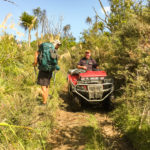
The most important on the list of etiquette rules for hiking is to be considerate, be compassionate and helpful to fellow hikers. By thinking about others, making sure you’re not taking up too much space, or interfering with others’ enjoyment of the trail you’ll help to make the trails a more enjoyable and peaceful place for everyone to enjoy.
Why do uphill hikers have right of way?
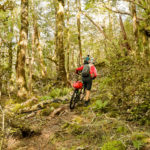
The main reason why uphill hikers have right of way over downhill hikers is because it takes more energy to walk uphill than it does downhill. Therefore, it makes sense that the person going downhill should step aside and allow the person going uphill to keep their momentum.
Final Thoughts: Hiking Etiquette.
It can be tough to swallow that even out in the middle of nowhere there might be rules to follow. But in any place where people have to coexist and get along together, it’s always better if we can be kind and courteous to each other.
Which is where these hiking etiquette rules for hiking and tramping come in. I hope they’ll help you minimise your impact on the environment and the other humans trying to enjoy the trails just like you!
Use these basic rules to learn how to be a kind and considerate trail user, respect others’ use of the trail and the natural environment, and don’t get labelled a d*ck!
If you enjoyed this hiking etiquette post, please take a moment to help me spread the word to other trampers by sharing it on Pinterest or social media.


